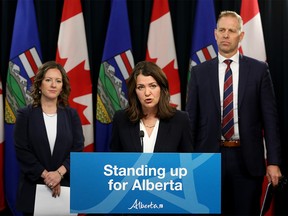
A curious conundrum about setting targets is what to do once they’re almost reached.
On Monday, federal Environment Minister Steven Guilbeault answered that question on the issue of methane emissions from the Canadian oilpatch — aim higher.
At the COP28 climate summit in Dubai, Guilbeault released Canada’s new draft regulations that will require the upstream oil and gas industry to reduce its methane emissions by at least 75 per cent (from 2012 levels) by the end of this decade.
The announcement comes two years after the federal Liberal party campaigned on making the deep cut on methane levels, while also pledging to introduce a cap on all greenhouse gas emissions from the Canadian oil and gas industry.
It also follows the U.S. and Canadian governments agreeing in March 2016 to lower methane emissions from the oil and gas industry by 40 to 45 per cent by 2025.
Last month, the Alberta government announced it had reached the target to lower emissions by 45 per cent by 2025, three years ahead of schedule.
It appears the national target for industry is also within reach.
“We are on track to surpass our goal ahead of schedule, so today’s announcement builds on past success,” Guilbeault said at the international conference.
“I am very happy to announce the release of even more ambitious draft methane regulations for Canada’s oil and gas sector.”
It’s fair to say the industry remains deeply worried about the broader oilpatch emissions cap and its potential to curtail production, but on the methane regulations, that doesn’t seem to be the case.
“The federal government clearly seems to have listened to some of the past concerns and the regulations seem to be now going in the right direction,” Tristan Goodman, president of the Explorers and Producers Association of Canada, said in an interview.
“Yes, there is an increased cost to industry. But if this is implemented correctly, it is a manageable cost that industry was likely moving toward already . . . It actually is achievable.”
Producers said the final details of the regulations will be critical. Yet, they point to the progress that’s been made to reach the earlier target.
“I know at the field level, it has been a focus of a lot of producers to reduce methane emissions,” said Phil Hodge, CEO of Calgary-based gas producer Pine Cliff Energy.
“We are already well advanced and I think we will continue to lead the world.”
Michael Belenkie, chief executive of Advantage Energy, noted his company lowered its methane emissions intensity by 10 per cent between 2021 and 2022.
It has deployed solar panels to aid in emissions reductions, replaced pneumatic devices, has adopted a strategy that includes fugitive emissions management and eliminated unintended venting.
“While there may be some producers in Canada that will have to pull up their socks on this because of the nature of their assets, broadly speaking, if Canada and the States are moving in lockstep, this will be tougher for Americans to adjust than for Canadians, because we’ve done so much hard work,” Belenkie said.
“Speaking for Advantage, we believe that we’re in pretty good shape.”
-
 New proposed methane emission targets draw pushback from Alberta government
New proposed methane emission targets draw pushback from Alberta government -
 Canada proposes sweeping new methane emissions rules for oil-and-gas sector
Canada proposes sweeping new methane emissions rules for oil-and-gas sector -
 Varcoe: A ‘nastier fight’ — Here comes the emissions cap and a high-stakes federal-provincial donnybrook
Varcoe: A ‘nastier fight’ — Here comes the emissions cap and a high-stakes federal-provincial donnybrook
Methane, the main component in natural gas, doesn’t stay in the atmosphere as long as carbon dioxide (CO2) emissions, although it has a greater climate impact. Methane is considered to be 86 times more harmful than CO2 over a two-decade period.
According to the federal government, oil and gas facilities are the largest emitters of methane, responsible for about 40 per cent of such emissions in 2021. Most of it is emitted during venting or as fugitive emissions coming from equipment.
The Alberta government released a statement on Monday morning, blasting Ottawa and asserting that it is the province’s constitutional right to manage emissions from the industry.
“Once again, the federal government is setting unrealistic targets and timelines. Infrastructure can only be updated as quickly as technology allows,” Premier Danielle Smith and Environment Minister Rebecca Schulz said in a joint statement.
“Given the unconstitutional nature of this latest federal intrusion into our provincial jurisdiction, our government will use every tool at our disposal to ensure these absurd federal regulations are never implemented in our province.”

The new draft regulations will require a third-party audit and inspection of companies reporting on their methane emissions, as well as prohibit venting (with some exceptions) and have new flaring limits.
The federal government estimates the cost to comply with the regulations will be about $70 per tonne of GHG emissions reductions.
Environment and Climate Change Canada says the conservation steps would save the industry up to $1 billion in lost revenue, while incremental compliance costs are estimated at $15.4 billion between 2027 and 2040.
At the COP28 summit, 50 global oil and gas producers — making up about 40 per cent of total production — have agreed to drop their CO2 emissions to net zero by 2050 and reduce methane emissions to near zero by the end of this decade.
Consultancy S&P Global Commodity Insights noted the commitment will require the producers to set interim targets to cut methane emissions to 0.2 per cent of oil and natural gas production by 2030, and to end routine flaring.
Engineering professor Matthew Johnson, who heads the Energy & Emissions Research Lab at Carleton University, noted the European Union has agreed to bring in maximum methane intensity values for natural gas and oil that is imported.
There are a lot of “big steps” included within Canada’s draft regulations, such as rules over venting, he added.
“Absolutely, 100 per cent, this is an achievable target,” Johnson said.
“We have to do this in Canada.”
Chris Varcoe is a Calgary Herald columnist.
You can read more of the news on source


